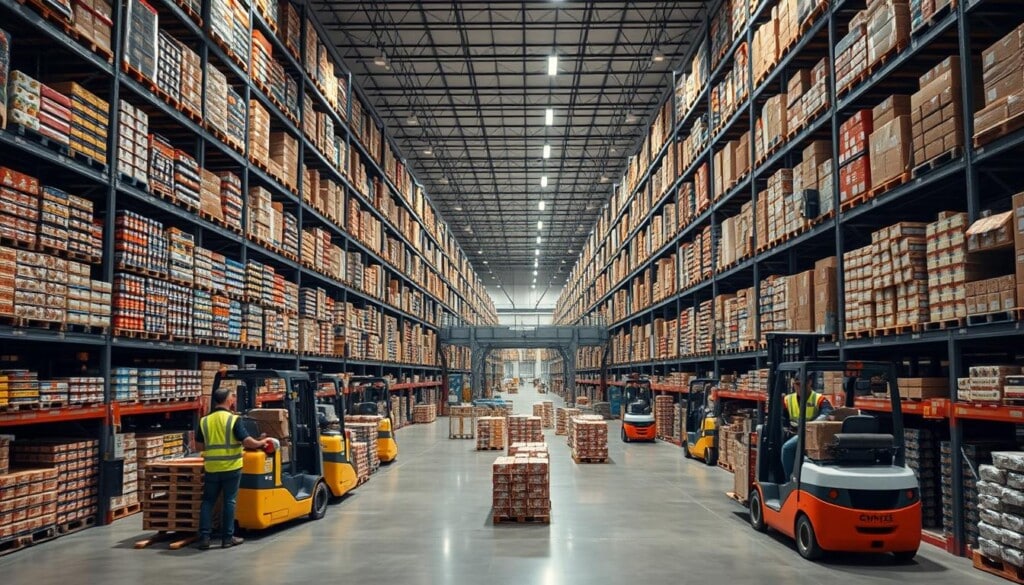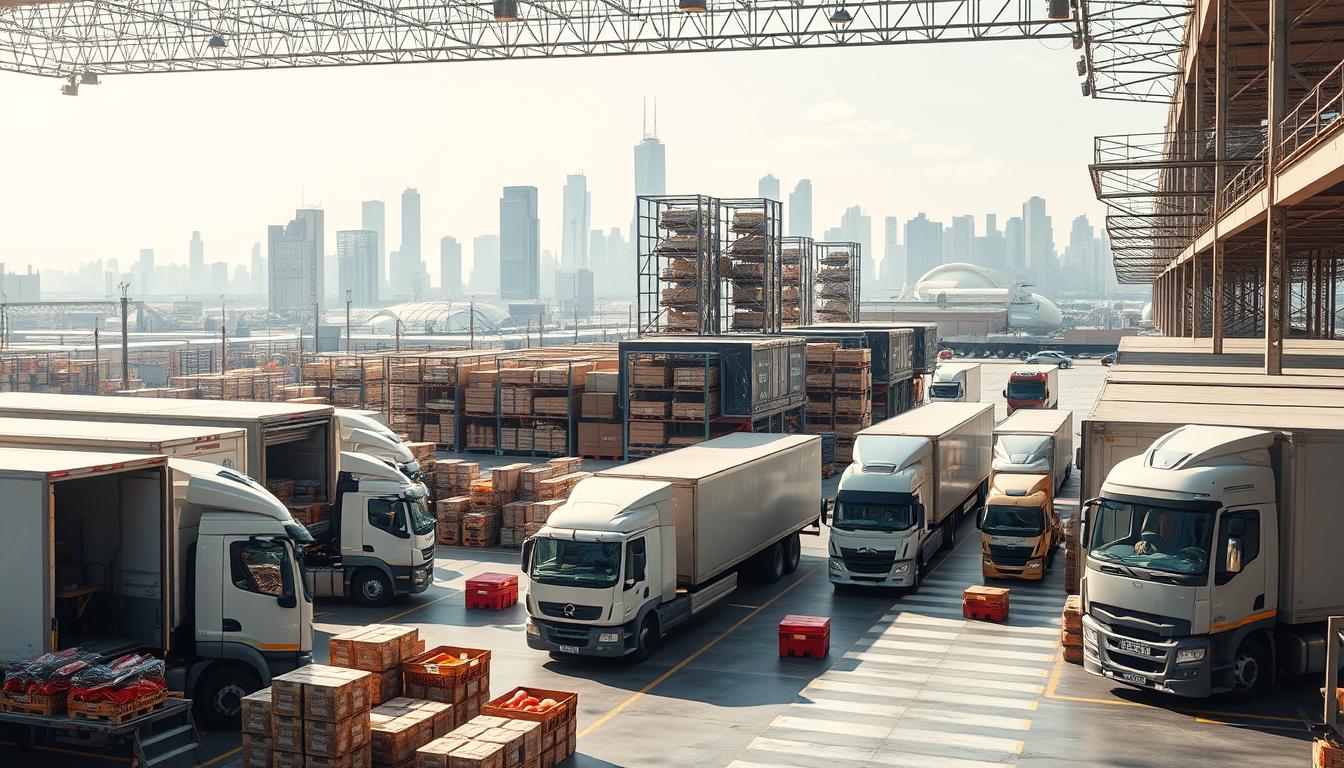Ever wonder who brings food to your table every day? The food distribution sector in the United States is key. It connects food producers with those who eat it, like grocery stores and restaurants. This article looks at the top food distributors, highlighting their role in supplying and distributing food.
We’ll explore how they work, the benefits they offer, and their big impact on local economies and communities.
Learning about these companies shows their vital role in getting products to market. They help not just the economy but also keep communities connected. For more on food distribution, check out LocalZ directory. It helps businesses find local resources.
Key Takeaways
- The food distribution sector bridges producers with end consumers.
- Top food distributors exemplify excellence in wholesale food supply.
- Local distributors play a critical role in community engagement.
- Understanding distribution channels is key for restaurants and retailers.
- Economic impact extends from local to national scales.
Understanding the Food Distribution Landscape
Food distribution is key in getting food from farms to our plates. It involves moving food through a system that includes processing, storage, and delivery. This ensures we get fresh food when we need it.
What is Food Distribution?
Food distribution is about moving food from farms to us. It’s a complex process that needs teamwork from many players. Companies work together to manage logistics, keep food quality high, and deliver on time.
Key Players in the Industry
Big names like Sysco, US Foods, and Performance Food Group lead the industry. They are major suppliers that influence the market. Their large networks help them deliver to restaurants and stores all over the country.
Importance of Local Distributors
Local distributors are vital for connecting local farmers with consumers. They focus on fresh, local food, boosting local farms. This approach makes food distribution more efficient, helping both businesses and communities.
How Food Distributors Operate
Understanding how food distributors work is key to seeing the industry’s complexity. They handle many tasks like finding, storing, and moving food. These tasks are vital for the supply chain, helping food wholesalers deliver a wide range of products.
Supply Chain Processes
The supply chain starts with finding ingredients from suppliers. Then, these items are moved to warehouses for storage. Good inventory management keeps the products fresh and ready for delivery to places like restaurants and grocery stores.
Distribution Channels Explained
Distribution channels differ in the food industry. Some distributors deliver products directly to places like restaurants. Others use third-party logistics to handle deliveries, letting them focus on finding and storing food. Each method helps improve efficiency and reach more customers.
Logistics and Transportation
Logistics are critical for food distributors. Good transportation plans ensure products arrive on time and in good condition. Keeping an eye on things like temperature and delivery time helps avoid spoilage and keeps customers happy. These strategies are important for the food distribution sector’s success.

Benefits of Partnering with Food Distributors
Working with food distributors brings many benefits to foodservice businesses. Restaurants can save money and improve service quality by teaming up with wholesale food suppliers. This partnership makes buying easier and helps focus on serving customers better.
Cost-Effective Solutions for Restaurants
Food distribution services help restaurants save money through bulk buying. This approach cuts down costs per item. It also frees up resources for improving customer service. Many suppliers offer prices that can really help a restaurant’s finances.
Access to a Variety of Products
Food distributors offer a wide range of products. This makes it easier for restaurants to offer different menu items. It also helps them keep up with changing tastes and trends. Working with trusted suppliers keeps restaurants competitive.
Streamlined Inventory Management
Team up with food supplier companies for better inventory management. They use advanced systems to track stock levels in real-time. This makes running the restaurant more efficient. It helps keep the right amount of stock and cuts down on waste, so restaurants can focus on serving customers better.
LocalZ: Connecting Businesses and Communities
LocalZ is a new online directory that connects local businesses with their communities. It helps businesses show off their services and products. This makes it easier for people to find and support local distributors and suppliers.
This approach boosts local economies. It focuses on selling items from the area and helps small businesses grow.
Revolutionizing Local Business Engagement
LocalZ does more than just list businesses. It helps connect consumers with local owners. This makes it easy to find food distributor services.
This system helps local businesses thrive. They can meet community needs while growing.
How LocalZ Supports Local Economies
Using LocalZ helps build a strong community. It gives local farmers and producers a platform. This boosts the economy, creating jobs and stability.

Navigating the LocalZ Directory
The LocalZ directory makes it easy to find food distribution services that fit your needs. It has a simple search system that helps you find reliable providers quickly. This makes it easier for businesses to find the resources they need.
Searching for Food Distributors
Looking for food distributors is easy with the LocalZ directory. You can use the search function to find local options fast. The results show different choices, helping businesses find the right distributor.
Filtering Listings for Your Needs
LocalZ offers filters to make your search better. You can filter by product types, service areas, and customer feedback. This saves time and helps you find what you need quickly.
Reading Reviews and Ratings
Reviews and ratings are key in the LocalZ directory. They help you understand the quality and reliability of food distribution services. This information helps you make better choices when choosing a distribution partner.
Making the Right Choice: Selecting a Distributor
Choosing the right food distributor is a big decision. You need to look at many factors to make sure it fits your business. Knowing what food supplier companies can do and their services is key to a good partnership.
Factors to Consider When Choosing
Look at the distributor’s product range and if they have what you need. Check if they can deliver on time and reliably. Good customer service is important too, as it helps solve problems.
Also, find out how they source their products and their pricing. This helps you see if they’re a good fit for your business.
Questions to Ask Potencial Distributors
When talking to food supplier companies, ask important questions. Find out about their logistics and how they source products. Ask about their order turnaround and return policies.
This research helps you choose a distributor that matches your business values and goals.
Community Impact of Food Distribution Businesses
Food distribution companies are key to boosting local economies and helping agricultural communities. They work closely with local farmers and producers. This ensures that fresh, local products get to consumers quickly.
This focus on local sourcing strengthens ties in the agricultural sector. It also promotes sustainability in the community.
Supporting Local Farmers and Producers
Bulk food suppliers team up with regional farmers, giving them a reliable way to sell their products. This partnership helps local agricultural goods get noticed and sold. It helps keep local farming alive and supports the food supply chain.
Jobs and Economic Growth
The effects of food distribution businesses go beyond farming. They create jobs in logistics, sales, and customer service. This boosts local economies.
More jobs mean more income for people, which helps the community grow. Food distribution companies also support local initiatives. This shows their dedication to the communities they serve.
The Future of Food Distribution
The food distribution world is changing fast, thanks to new trends and tech. Consumers want things to be easier and more efficient. So, food distribution services are using new ways to stay ahead and meet these needs.
Trends Shaping the Industry
There’s a big move towards more flexible supply chains. This lets distributors meet customer needs better and cut down on waste. Now, being green is key, guiding how they work and who they buy from.
Buying local is also big, helping local farmers and making food fresher. It also strengthens community bonds.
Technology in Food Distribution
Technology is key in changing food distribution. Tools like AI and data analytics help manage stock and track things in real-time. They make things run smoother and help guess what customers will want.
By using tech, food services can serve customers better and stay ahead. This makes them ready for what’s next.

Get Involved with LocalZ Today
Joining the LocalZ directory is a smart move for businesses. It helps them show off their services to people looking for local options. This is key for businesses wanting to reach out to their community.
Being part of LocalZ does more than just list your business. It connects you with the people who live nearby. It encourages people to buy from local shops and farmers. This helps the local economy grow and supports informed shopping choices.
LocalZ changes how businesses and communities interact. It doesn’t just list businesses; it makes them a part of the neighborhood. This way, businesses can really connect with their customers and help make their area better.

